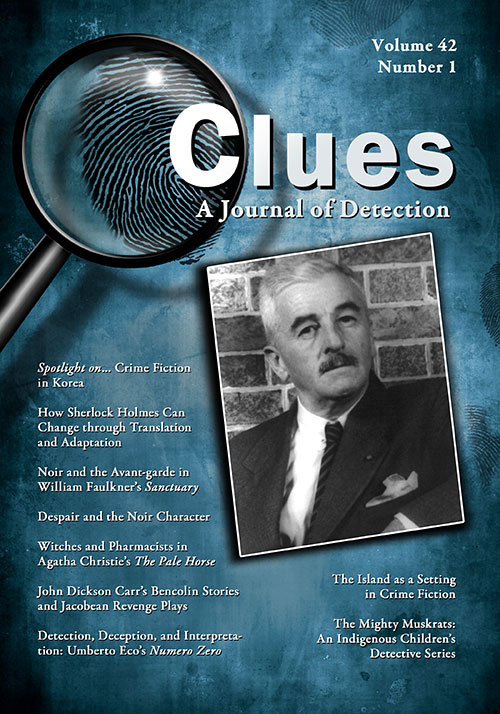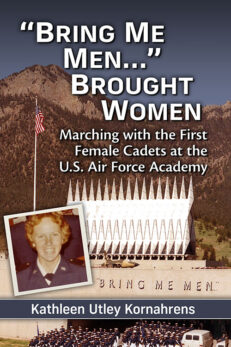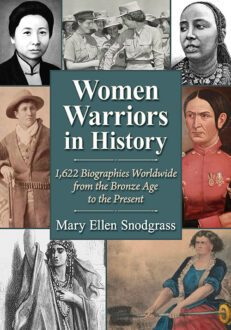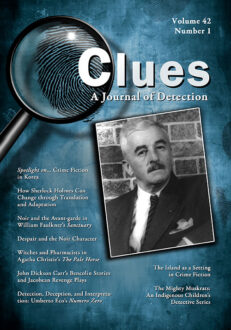Clues: A Journal of Detection, Vol. 42, No. 1 (Spring 2024)
Print Back Issue$30.00
In stock
About the Book
BACK ISSUE
This is a single back issue only. To order a current subscription, or for more information, please visit the journal’s web page at CluesJournal.com. Back issues from earlier volumes of Clues are available for order subject to availability. Also, single issues of the current volume may be ordered one at a time. Individuals may order back issues directly from our online catalog, and the charge for individuals is $30 (excluding postage). Issues from Volume 33 to the present are also available in ebook format on Kindle, Nook and Google Play.
The charge for single issues for institutions is $75 per issue (excluding postage). If your institution requires a back issue, please contact us to order at the appropriate rate.
About the Author(s)
Bibliographic Details
Executive Editor Caroline Reitz
Managing Editor Elizabeth Foxwell
Consulting Editor Margaret Kinsman
Format: softcover (7 x 10)
Pages: 120
Bibliographic Info:
Copyright Date: 2024
ISSN 0742-4248
Imprint: McFarland
Table of Contents
Introduction: A Kaleidoscope of Cultures and Works
caroline reitz 5
The executive editor of Clues provides an overview of the issue, including articles on John Dickson Carr; Agatha Christie; Arthur Conan Doyle in Dutch translation; Umberto Eco; a YA mystery series featuring Indigenous issues; island mysteries; Korean crime fiction; and noir’s relationship with works by William Faulkner, David Goodis, and John D. MacDonald.
Spotlight on… Crime Fiction in Korea: Transformation and Transnationality of the Genre
jooyeon rhee 9
This essay traces the transnational literary flow and popular imaginations of modernity in colonial Korea (1910–45), the effect of the Korean War and the Cold War, and diverse responses to global neoliberalism in contemporary Korea. It highlights representative themes in each period and notable writers in modern crime fiction.
“A Modernist Lampstand”: Noir and the Avant-garde in William Faulkner’s Sanctuary
alex davis 25
This essay considers Sanctuary in the context of William Faulkner’s career-long predilection for crime fiction, interpreting his avant-garde appropriation and manipulation of genre writing in the novel against the background of its relationship to American naturalism (including the noir novel) and nineteenth-century European realism.
Despair and the Noir Character
michael caleb tasker 36
Noir’s atmosphere of anxiety and/or despair stems not from environment and setting but rather from character and from an outsider defined by and riddled with a very Kierkegaardian sense of existentialist despair. As works by John D. MacDonald and David Goodis demonstrate, the despairing protagonist is the foremost defining characteristic of noir fiction.
“Nobody in the Renaissance conceived of a revenge quite so delicious”: John Dickson Carr’s Bencolin Stories and Jacobean Revenge Plays
lisa hopkins 47
This article argues that John Dickson Carr’s first four novels about Inspector Henri Bencolin each draw from a different early modern revenge tragedy: It Walks by Night alludes to John Webster’s The Duchess of Malfi; Castle Skull borrows names and atmosphere from Henry Chettle’s Hoffman; The Lost Gallows nods to Thomas Kyd’s The Spanish Tragedy; and The Corpse in the Waxworks evokes Thomas Middleton’s and William Rowley’s The Changeling.
Detection, Deception, and Interpretation: Umberto Eco’s Numero Zero
rhys william tyers 53
In Numero Zero, Umberto Eco employs the tropes of the postmodernist detective novel to investigate interpretation, textual disorientation, and the problematic influence of the news industry. The message seems to be that we need to all become better detectives regarding language interpretation and manipulation.
How Sherlock Holmes Can Change Through Translation and Adaptation: A Case Study of “The Red-Headed League”
jo de brie 64
A Dutch translation of the Arthur Conan Doyle short story “The Red-Headed League,” published in serial form in the Flemish newspaper Het Volk in 1911, displays considerable changes from the original. Sherlock Holmes is more generic and superficial, references to London are much vaguer, and lowbrow features are augmented. This translation strategy is connected to the intended readership.
Witches and Pharmacists in Agatha Christie’s The Pale Horse
sylvia a. pamboukian 75
At first glance, witches and pharmacists have little in common. Yet Agatha Christie’s The Pale Horse imaginatively links these unlikely figures through a common desire for greater visibility and social power, offering an astute analysis of the dynamics of self-representation, the consequences of social invisibility, and the benefits of reading beyond the puzzle plot into the seemingly marginal details of detective fiction.
Islands of Crime: The Island as a Setting in Crime Fiction
šárka bubíková and olga roebuck 88
The article explores how the traditional notions of islandness such as boundedness, isolation, and remoteness are validated or subverted in mystery novels by Philip R. Craig, Robert Harris, P.D. James, Peter May, and Cynthia Riggs that have an island setting and a detective who is an insider or an outsider.
The Mighty Muskrats: An Indigenous Children’s Detective Series
amy cummins 98
This article analyzes the cultural content and literary elements of the first children’s detective series by an Indigenous (First Nations) author. Four cousins investigate cases of local and systemic injustice in the Mighty Muskrats mystery series (Second Story P, 2019– ) by Michael Hutchinson, a citizen of the Misipawistik Cree Nation.
REVIEWS
David Bordwell. Perplexing Plots: Popular Storytelling and the Poetics of Murder
phyllis m. betz 111
Sian MacArthur. Gender Roles and Political Contexts in Cold War Spy Fiction
heike henderson 112
Fabricio Tocco. Latin American Detectives Against Power: Individualism, the State, and Failure in Crime Fiction
clare rolens 114
Sylvia A. Pamboukian. Agatha Christie and the Guilty Pleasure of Poison
annika r.p. deutsch 115
Author Guidelines are on page 118.
Book Reviews & Awards
- “Clues is a must-have for readers and writers of crime fiction. Scholarly, thought-provoking, wide-ranging in its topics, Clues covers the crime and thriller map.”—Sara Paretsky
- “A. Conan Doyle, notoriously resentful of Sherlock Holmes’s success, liked to scorn ‘police romances’ as less significant and worthy of his talents than his other literary work. If he could have read Clues, the thinking mystery reader’s journal, he would surely have felt differently—and learned much he never realized himself about even his own landmark contribution to the genre, from which so much else by others has flowed.”—Jon Lellenberg, U.S. agent for the Arthur Conan Doyle estate
- “I love reading Clues. Every issue provides thought-provoking, well-researched articles. The variety and scope of the material found in Clues makes an unparalleled, ongoing contribution to our understanding of the role of crime fiction in our culture, and the genre’s reflection of its time and society.”—Jan Burke, Edgar-winning author of The Messenger (2009)
- “Clues is an important journal. It carries the torch of tradition that is the backbone of detective fiction. It goes below the surface and gets to the heart of what makes the genre so fascinating and valid today”—Michael Connelly, author of the Harry Bosch novels, including The Overlook (2007)
- “for erudite and fascinating truths about mysteries, follow the clues to Clues, the scholarly journal that is an essential resource for every serious student of the mystery”—Carolyn Hart, author of Death Walked In (2008)
- “with scholarship ranging from Poe to Peters, nothing beats Clues”—Joan Hess, author of Mummy Dearest (2008).





